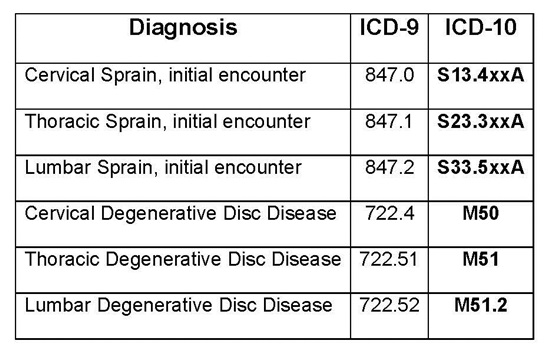 How to Convert ICD-9 Codes to ICD-10 Codes How to Convert ICD-9 Codes to ICD-10 Codes

ICD-10 is not an update to an existing code set; it is a whole new code set. The ICD-10 code sets have fundamental changes in structure and concepts that make them very different from ICD-9. Because of these differences, it is important to develop a preliminary understanding of the changes from ICD-9 to ICD-10. The ICD-9 classification has about 13,000 codes. In the ICD-10 classification of codes, there are over 65,000 codes. The variation of codes is staggering.
The good news is that only about 70 codes are commonly used in the chiropractic profession.
Much of the reason for this great expansion is due to the fact that ICD-10 codes are more specific than anything we use today. Because the codes allow for greater specificity, using an unspecified code may lead carriers to question why the code was used.
ICD-10 may require that more than one code is assigned to a condition. Virtually every diagnosis code will be different and long-standing coding guidance will not apply to ICD-10. The biggest challenge will be to "unlearn" ICD-9 coding guidance and go back to basics to learn ICD-10 coding.
When we compare the ICD-9 and ICD-10 codes below, you can see the vast difference.

Keep in mind that while many codes in ICD-9-CM map directly to codes in ICD-10, in some cases, a clinical analysis will be required to determine which code or codes should be selected.
For example, when you convert the ICD-9 code for cervical sprain (847.0) to the ICD-10 codes; the ICD-9 code maps to 2 different ICD-10 codes, and only the most appropriate code should be reported.
Note the specificity in the code descriptions below. When comparing the codes in this manner, it is important to recognize that your documentation must be consistent with the code reported.
ICD-9 "847.0" (assuming initial encounter) maps approximately to either:
- ICD-10 "S13.4XXA" - Sprain of ligaments of cervical spine, initial encounter, OR
- ICD-10 "S13.8XXA" - Sprain of joints and ligaments of other parts of neck, initial encounter.
ChiroCode's ICD-10 Coding for Chiropractic (Second Edition)
There will be many situations in which you will need to map the ICD-9 code to the most appropriate ICD-10 code. HNS encourages all practicing chiropractors to purchase ChiroCode's ICD-10 Coding for Chiropractic (Second Edition). This book is perhaps the best ICD-10 chiropractic resource for converting ICD-9 codes to ICD-10 codes and includes an ICD-9 to ICD-10 code map. HNS has negotiated a 10% discount off the purchase price of this book, plus free shipping and handling, for HNS providers. Click here for information about how to order and receive the HNS discount.
HNS Translator Tool
To make the conversion process easier, HNS is providing a code conversion table, which includes a list of the top 100 diagnoses (reported by HNS providers) and the most likely corresponding ICD-10 codes. This list was prepared for HNS by Dr. Mario Fucinari, a nationally known expert in ICD-10 for chiropractic.
Disclaimer:
The information in the HNS Code Translator is based on the General Equivalency Mapping (GEM) files published by CMS, and are not intended to be used as an ICD-10 conversion, ICD-10 mapping or ICD-9 to ICD-10 crosswalk tool. While many codes in ICD-9-CM map directly to codes in ICD-10, in some cases, a clinical analysis will be required to determine which code or codes should be selected, and there will be many situations in which you will need to map the ICD-9 code to the most appropriate ICD-10 code.
Click here for the HNS Code Translator
General Equivalency Mappings (GEMS)
Created by CMS, GEMS are a tool that can be used to convert data from ICD-9-CM to ICD-10-CM (and ICD-9-PCS to ICD-10-PCS) and vice versa. Mapping from ICD-10 back to ICD-9 is referred to as backward mapping and mapping from ICD-9 to ICD-10 is referred to as forward mapping. The GEMS are a comprehensive translation dictionary that can be used to accurately and effectively translate any ICD-9-CM based data, for:
Tracking quality;
Recording morbidity/mortality;
Calculating reimbursement; or
Converting any ICD-9-CM/PCS based application to ICD-10-CM/PCS.
The GEMS are not a substitute for learning how to use ICD-10. Physicians and coding staff will assign codes describing patient encounters from the ICD-10 code books, such as ChiroCode's ICD-10 Coding for Chiropractic (Second Edition). It will be much more efficient to work from the health care record documentation and then select them most appropriate code from the code book.
|
 Health Network Solutions, Inc. (HNS) stands alone as the oldest and largest chiropractic network in the Southeast.
Health Network Solutions, Inc. (HNS) stands alone as the oldest and largest chiropractic network in the Southeast.